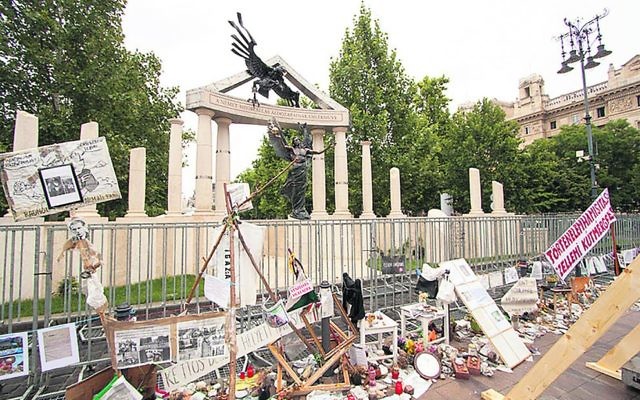ZAKA’s Danube search mission for the truth
Shoah victims need not dwell in the depths of the Danube when a viable alternative exists that can lay these innocent souls to rest.
IN Budapest’s Liberty Square, a ruthless German eagle swoops down to attack the broken-winged archangel Gabriel.
The infamous statue, titled Memorial to the victims of the German invasion, was erected during Hungary’s 70th commemoration to honour the victims of the 1944 German occupation, and paints a disconcerting picture of Hungary as the guiltless victim of Nazi rule.
At the time of the statue’s instalment in 2014, Hungary’s right-wing Prime Minister Viktor Orbán reportedly described the memorial as “morally precise and immaculate”, adding to the government’s ultranationalist rhetoric, but the statue’s deeply flawed symbolism was rightly met with fierce opposition.
In a concerted effort to more accurately portray Hungary’s culpability in the Holocaust, locals began an unofficial protest monument, which now lines the cobblestoned footpath immediately in front of the official memorial.
One particularly pertinent, haunting hand-written note reads, “My mother was killed in Auschwitz. Thank you Archangel Gabriel.”
Bearing trinkets, letters and family photos, the counter-memorial is a constantly evolving composition; without it, visitors would undoubtedly gain a highly skewed version of history that fails to account for the thousands of Jews shot and thrown into the Danube between 1944 and 1945 by the Hungarian Nazi-allied Arrow Cross Party, among various other atrocities in which Hungary was complicit.
Considering the country’s continued attempts to obfuscate this history, last week’s announcement that the Israeli search-and-rescue organisation ZAKA – with the support and assistance of the Hungarian government – is sending divers into the River Danube to search for the remains of Holocaust victims, is a promising move that may point to a greater willingness on Hungary’s part to accept the chilling ghosts of its chequered past.
However, the rescue mission was at ZAKA’s initiation, and although Hungary has offered its assistance, the nation is a long way off accepting full responsibility for its historical wrongdoings.
In recent years, many Hungarian Jews and leading Holocaust scholars have argued that the construction of a new Holocaust museum in Budapest, expected to open next year, falsifies history by omitting certain details about Hungary’s part in the deportation and persecution of Jews.
Given this, it is unsurprising, though no less displeasing, that a comprehensive search effort has taken over seven decades to proceed. According to Israel National News, up until now, there have been no attempts to locate and retrieve the bones of these Holocaust victims.
In 2011, though victims’ remains found during the renovation of Budapest’s Margit Bridge were later buried in a Jewish cemetery in Budapest, the discovery did not prompt Hungary into initiating a full-scale search.
If the Hungarian government was truly committed to accepting responsibility and honouring victims who perished from the mass executions committed by Arrow Cross, one would think investigations and subsequent proper burials would have been initiated years – if not decades – ago.
Seventy-five years on, perhaps too much time has passed for the mission to yield any fruitful outcome, and last Thursday, Hungary’s largest Jewish group called for Israeli and Hungarian authorities to cease the search.
“Bones have probably scattered in the 75 years and could have been washed as far downstream as the Black Sea … searching for them is needless, and breaches the peace and dignity of the dead, Jewish or Goyim. It breaches the halachah,” the Federation of Hungarian Jewish Communities, or Mazsihisz, noted on its website.
Perhaps those opposed to the search are rightly concerned about the myriad ethical issues – would all the potential families of victims found support the search mission, could discoveries spark disputes within families regarding what should happen to the remains, and this many years on, can the bodies be identified, anyway?
In regards to the latter concern, quite plausibly, the answer is no.
“It was impossible to tie the bones to individual people,” Mazsihisz’s president Andras Heisler told Hungary’s Index news website, referring to the remains discovered in 2011.
“Historical research shows that the number of people shot into the Danube in 1944 is in the thousands, but many others perished in the river during the siege of Budapest as the end of the war drew closer. Their remains are likely to have been scattered all along the riverbed.”
But the potential identifiability of the remains should not determine whether or not the search proceeds.
Regardless of the outcome, Shoah victims need not dwell in the depths of the Danube when a viable alternative exists that can lay these innocent souls to rest.
Even when human remains are unidentifiable, society has always strived to act with a higher purpose – and when the remains are of Holocaust victims, whose final moments of life were tarnished with turmoil, pain and fear – even more reason that they should be laid to rest peacefully.
Just a few days ago, a funeral ceremony was held in London for the bones and ashes of six unknown Jewish victims of the Holocaust.
Like them, these victims of the Holocaust lying in the Danube deserve a proper Jewish burial, which, in addition to being a morally significant move for victims and their families, may provide Hungary with an opportunity to make amends for a whitewashed version of history they have propagated for far too long.
SOPHIE DEUTSCH is The AJN’s NSW arts editor.


comments